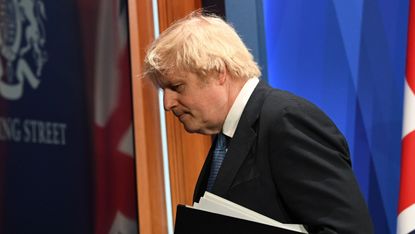When will the third wave of Covid peak?
Human behaviour will have a direct impact on the key numbers

Just as the country clawed back many of its freedoms this week, the number of Covid cases is starting to resemble the record levels seen over the winter.
While the UK’s vaccination programme means deaths and hospitalisations are on a much lower curve, the 1.7 million people self-isolating has led to disruption around the country.
So when will the latest surge be over? Here is what the data and models are showing.
Subscribe to The Week
Escape your echo chamber. Get the facts behind the news, plus analysis from multiple perspectives.

Sign up for The Week's Free Newsletters
From our morning news briefing to a weekly Good News Newsletter, get the best of The Week delivered directly to your inbox.
From our morning news briefing to a weekly Good News Newsletter, get the best of The Week delivered directly to your inbox.
The numbers
The gov.uk site shows that weekly coronavirus cases are up 36% on the previous seven days, with nearly 334,000 people testing positive between 15 and 21 July.
On both Friday and Saturday, the UK recorded more than 50,000 daily cases. “The last time case numbers were that high was in mid-January,” notes the BBC.
Health Secretary Sajid Javid has warned that this number could double to 100,000 during the summer, which would overtake the January peaks. However, he said: “What matters more than anything is hospitalisation and death numbers, and that is where the link has been severely weakened.”
Indeed, 88% of adults have now had one vaccination and 69% have had a second dose. This equates to more than 43 million people having at least some protection against the virus from inoculation.
As such, deaths and hospitalisations are much lower than the autumn and winter waves – but they are rising. Weekly deaths are up by 60% on the previous seven days, with 366 people reported to have died within 28 days of a positive test between 15 and 21 July, while hospital admissions are up 39% to 4,510.
The peak
Professor Neil Ferguson, of Imperial College London, who sits on the Scientific Advisory Group for Emergencies (Sage) committee, told The Andrew Marr Show at the weekend that it was “almost certain” the UK would reach 100,000 cases a day. “The real question is do we get to double that, or even higher?” he said.
Jane Merrick, at the i newspaper, has analysed the different scenarios put forward by three models assessed by Sage.
The best case, in a model by Warwick University, suggests daily hospital admissions could peak at below 1,000, while the worst case was put forward by Imperial, with 10,000 admissions predicted. However, this was based on there being little protection from vaccines and natural immunity so is “very unlikely”, says Merrick. The central estimate is between 1,000 and 2,000 a day by the peak.
One reason for the wide range of predictions is that people’s behaviour is “unknowable”, particularly once restrictions were lifted on 19 July, says Professor Graham Medley, chair of the Scientific Pandemic Influenza Group on Modelling (Spi-M), a subgroup of Sage.
Speaking to BBC Radio 4’s Today programme last week, he said the length of the wave was also hard to map as previous peaks had been controlled by lockdown measures.
If the intention is not to introduce a lockdown this time, “then we are going to see a natural peak and that may well be long and disseminated”, continued Medley.
“So even if we don’t get up to very high numbers, the numbers that we get up to might last for several weeks, in which case there’s still a considerable burden on healthcare.”
In the Downing Street press conference on Monday, Chief Scientific Adviser Sir Patrick Vallance agreed that “the timing of the peak is uncertain”. The models vary on the timing and “it could even be that you get a peak that goes back down and comes back up again”, he said.
Most of the forecasts suggest there should be “a peak and some kind of plateau” next month, added Vallance.
The government’s deputy chief medical officer, Professor Jonathan Van-Tam, agreed with Medley that the epidemic would be driven by human behaviour over the next four to six weeks.
If we don’t “tear the pants out of this we will materially affect the size and shape of this epidemic curve, where the peak occurs and how big it is”, he said. “It is literally in the hands of the public.”
Create an account with the same email registered to your subscription to unlock access.
Sign up for Today's Best Articles in your inbox
A free daily email with the biggest news stories of the day – and the best features from TheWeek.com
-
 5 high-caliber cartoons about Kristi Noem shooting her puppy
5 high-caliber cartoons about Kristi Noem shooting her puppyCartoons Artists take on the rainbow bridge, a farm upstate, and more
By The Week US Published
-
 The Week Unwrapped: Why is the world running low on blood?
The Week Unwrapped: Why is the world running low on blood?Podcast Scientists believe universal donor blood is within reach – plus, the row over an immersive D-Day simulation, and an Ozempic faux pas
By The Week Staff Published
-
 Rishi Sunak's asylum spat with Ireland explained
Rishi Sunak's asylum spat with Ireland explainedIn Depth Irish government plans to override court ruling that the UK is unsafe for asylum seekers
By The Week UK Published
-
 Is the Gaza war tearing US university campuses apart?
Is the Gaza war tearing US university campuses apart?Today's Big Question Protests at Columbia University, other institutions, pit free speech against student safety
By Joel Mathis, The Week US Published
-
 Is there a peaceful way forward for Israel and Iran?
Is there a peaceful way forward for Israel and Iran?Today's Big Question Tehran has initially sought to downplay the latest Israeli missile strike on its territory
By Sorcha Bradley, The Week UK Published
-
 How could the Supreme Court's Fischer v. US case impact the other Jan 6. trials including Trump's?
How could the Supreme Court's Fischer v. US case impact the other Jan 6. trials including Trump's?Today's Big Question A former Pennsylvania cop might hold the key to a major upheaval in how the courts treat the Capitol riot — and its alleged instigator
By Rafi Schwartz, The Week US Published
-
 Is the next cold war a drone-swarm race between US and China?
Is the next cold war a drone-swarm race between US and China?Today's Big Question Both global superpowers are building up their capacity for surging robotic warfare. What happens next is anyone's guess.
By Rafi Schwartz, The Week US Published
-
 How powerful is Iran?
How powerful is Iran?Today's big question Islamic republic is facing domestic dissent and 'economic peril' but has a vast military, dangerous allies and a nuclear threat
By Harriet Marsden, The Week UK Published
-
 Why are Republicans trying to change Nebraska's Electoral College vote?
Why are Republicans trying to change Nebraska's Electoral College vote?Today's Big Question It's a chance for Donald Trump to block Joe Biden's path to re-election
By Joel Mathis, The Week US Published
-
 Is it time to end arms sales to Israel?
Is it time to end arms sales to Israel?Today's Big Question Democrats urge restrictions following World Kitchen convoy deaths
By Joel Mathis, The Week US Published
-
 Have we entered the age of AI warfare?
Have we entered the age of AI warfare?Today's Big Question Israeli military used AI to create 'kill lists' of suspected Hamas militants, say local media
By Sorcha Bradley, The Week UK Published